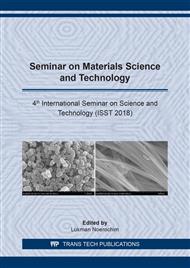[1]
Wang, X., Wang, X., and Wang T., (2017). An effective method for reducing free fatty acids content of high-acid rice bran oil by enzymatic amidation. Journal of Industrial and Engineering Chemistry, 48, 119-124.
DOI: 10.1016/j.jiec.2016.12.028
Google Scholar
[2]
Ju, Y.H., and Vali, S.R., (2005). Rice Bran Oil as a Potential Resource for Biodiesel: A Review. Journal of Scientific & Industrial Research, 64, 866-882.
Google Scholar
[3]
Rodrigues, C.E.C., Goncalves, C.B., Marcon, E.C., Batista, E.A.C., and Meirelles, A.J.A., (2014). Deacidification of rice bran oil by liquid–liquid extraction using a renewable solvent. Separation and Purification Technology, 132, 84-92.
DOI: 10.1016/j.seppur.2014.05.009
Google Scholar
[4]
Orthoefer, F.T., (2005). Rice bran oil in: F. Shahidi (Ed.), Bailey's Industrial Oil and Fat Products, Wiley Interscience, New Jersey, 465-489.
DOI: 10.1002/047167849x.bio015
Google Scholar
[5]
Wang, X., Lu, J.,Liu, H., Jin, Q., and Wang, X., (2016). Improved deacidification of high-acid rice bran oil by enzymatic esterification with phytosterol. Process Biochemistry, 51, 1496-1502.
DOI: 10.1016/j.procbio.2016.08.013
Google Scholar
[6]
Sun, P., and Armstrong, D.W., (2010). Ionic liquid in Analytical Chemistry. Analytica Chimica Acta, 661, 1-16.
Google Scholar
[7]
Niawanti, H., and Zullaikah, S. and Rachimoellah, M., (2017). Purification of Biodiesel by Choline Chloride Based Deep Eutectic Solvent. AIP Conference Proceedings Vol. 1840, Issue 1.
DOI: 10.1063/1.4982280
Google Scholar
[8]
Karimi, M., Dadfarnia, S., Shabani, A.M.H., Tamaddon, F., and Azadi, D., (2015). Deep Eutectic liquid organic salt as new solvent for liquid phase microextraction and its application in ligand less extraction and pre-concentration of lead and Cadmium in Edible Oil. Talanta, 144, 648-654.
DOI: 10.1016/j.talanta.2015.07.021
Google Scholar
[9]
Abbot, A.P., Capper, G., Davies, D.L., Rasheed, R.K., and Tambyrajah, V., (2003). Novel solvent properties of choline chloride/urea mixtures. Chemical Communications, 1, 70-71.
DOI: 10.1039/b210714g
Google Scholar
[10]
Shahbaz, K., Mjalli, F.S., Hashim, M.A, and Al Nashef, I.M., (2011). Eutectic solvents for the removal of residual palm oil-based biodiesel catalyst. Separation and Purification Technology, 81, 216-222.
DOI: 10.1016/j.seppur.2011.07.032
Google Scholar
[11]
Aini, H.Q., Heryantoro, R.P., Zullaikah, S. and Rachimoellah, M., (2017). Purifikasi Biodiesel Dari Minyak Dedak Padi Menggunakan Deep Eutectic Solvent: Pengaruh Rasio Molar Kolin Klorida dan Etilen Glikol Terhadap Kemurnian dan Yield Biodiesel. Tugas akhir, Departemen Teknik Kimia FTI-ITS.
DOI: 10.32734/jtk.v6i1.1559
Google Scholar
[12]
Kadapure, S.A., Kiran, A., Anant, J., Dayanand, N., Rahul, P. and Poonam, K., (2017). Optimization of conversion of Pongamia pinnata oil with high FFA to biodiesel using novel deep eutectic solvent. Journal of Environmental Chemical Engineering, 5, 5331-5336.
DOI: 10.1016/j.jece.2017.10.018
Google Scholar
[13]
Zahrina, I., Nasikin, M., Krisanti, E., and Mulia, K., (2018). Deacidification of Palm Oil using Betaine Monohydrate-based Natural Eutectic Solvents. Food Chemistry, 240, 490-495.
DOI: 10.1016/j.foodchem.2017.07.132
Google Scholar
[14]
Abbot, A.P., Harris, R.C., Ryder, K.S., D'Agostino, C., Gladden, L.F., and Mantle, M.D., (2011). Glycerol eutectics as sustainable solvent systems. Green Chemistry, 13, 82-90.
DOI: 10.1039/c0gc00395f
Google Scholar
[15]
Cui, Q., Peng, X., Yao, X. H., Wei, Z. F., Luo, M., Wang, W., et al. (2015). Deep eutectic solvent-based microwave-assisted extraction of genistin, genistein and apigenin from pigeon pea roots. Separation and Purification Technology, 150, 63-72.
DOI: 10.1016/j.seppur.2015.06.026
Google Scholar
[16]
Peng, X., Duan, M. H., Yao, X. H., Zhang, Y. H., Zhao, C. J., Zu, Y. G., et al. (2016). Green extraction of five target phenolic acids from Lonicerae japonicae Flos with deep eutectic solvent. Separation and Purification Technology, 157, 249-257.
DOI: 10.1016/j.seppur.2015.10.065
Google Scholar
[17]
Bahadori, L., Chakrabarti, M.H., Manan, N.S.A., Hashim, M.A., Mjalli, F.S., AlNashef, I.M., et al. (2015). The Effect of Temperature on Kinetics and Diffusion Coefficients of Metallocene Derivatives in Polyol-Based Deep Eutectic Solvents. PLoS ONE 10(12): e0144235. https://doi.org/10.1371/journal.pone.0144235.
DOI: 10.1371/journal.pone.0144235
Google Scholar
[18]
Bi, W., Tian, M., Row, K.H., (2013). Evaluation of alcohol-based deep eutectic solvent in extraction and determination of flavonoids with response surface methodology optimization. Journal of Chromatography A, 1285, 22-30.
DOI: 10.1016/j.chroma.2013.02.041
Google Scholar


